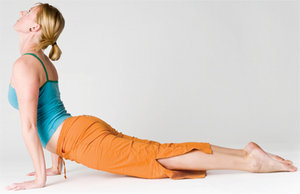Flat feet, a condition also known as excessive pronation, can produce slight twisting movements in the knees and hips, causing one hip to be higher than the other. This is usually more pronounced on one side and is not typically painful, but it explains why one knee or hip can develop soreness or stiffness more than the other one.
A Few Things You Can Do
Get checked - If your posture is breaking down as a result of improper foot balance, it is important to have your feet examined to determine if a custom-made, flexible shoe orthotic will be beneficial. Orthotics create a solid foundation for your pelvis and spine by limiting excessive motion in the feet. Having a stable foundation helps to improve your posture. Your doctor can provide you with more information.
Improve flexibility - This is important because postural stress causes some muscles to work harder than others, creating tension and stiffness. Mirror image exercises are stretching and strengthening exercises designed to restore muscle balance by stretching in the direction away from the postural imbalance. If you are looking in a mirror and one shoulder is higher than the other, you will want to stretch and strengthen in the direction that makes the shoulders level. The same concept works for the lower back. (Note: For a list of easy stretching exercises to help keep the entire body flexible, read "You've Got to Be Flexible" in the January issue of TYH.)
Work with your chiropractor - Be sure to work closely with your chiropractor in developing a plan of action, and then check your progress with a postural analysis. It is important to remember that the body works best when it is in balance, so that should be the goal of all of your stretching and strengthening exercises
Good posture does a whole lot more than just allow you to stand and walk tall. It's a full-body improvement that benefits you from head to toe.
 Benefits of Good Posture:
Benefits of Good Posture:
- Joint mobility
- Injury prevention
- Improved balance
- Overall wellness
Consequences of Poor Posture:
- Muscle tension
- Pain
- Fatigue
- Degenerative arthritis
Brian Jensen, DC, is a graduate of the University of Nebraska and Palmer College of Chiropractic. He specializes in structural biomechanics and has been in practice for 17 years.

